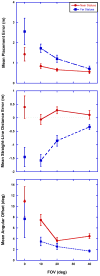Losing sight of the bigger picture: peripheral field loss compresses representations of space
- PMID: 17692884
- PMCID: PMC2693205
- DOI: 10.1016/j.visres.2007.06.012
Losing sight of the bigger picture: peripheral field loss compresses representations of space
Abstract
Three experiments examine how the peripheral visual field (PVF) mediates the development of spatial representations. In Experiment 1 participants learned and were tested on statue locations in a virtual environment while their field-of-view (FOV) was restricted to 40 degrees , 20 degrees , 10 degrees , or 0 degrees (diam). As FOV decreased, overall placement errors, estimated distances, and angular offsets increased. Experiment 2 showed large compressions but no effect of FOV for perceptual estimates of statue locations. Experiment 3 showed an association between FOV size and proprioception influence. These results suggest the PVF provides important global spatial information used in the development of spatial representations.
Figures







References
-
- Aivar MP, Hayhoe MM, Chizk CL, Mruczek REB. Spatial memory and saccadic targeting in a natural task. Journal of Vision. 2005;5(3):177–193. - PubMed
-
- Banks MS, Sekuler AB, Anderson SJ. Peripheral spatial vision: Limits imposed by optics, photoreceptors, and receptor pooling. Journal of the Optical Society of America: A. 1991;8:1775–1787. - PubMed
-
- Bishop PO, Henry GH. Spatial vision. Annual Review of Psychology. 1971;22:119–160. - PubMed
-
- Brockmole JR, Irwin DE. Eye movements and the integration of visual memory and visual perception. Perception & Psychophysics. 2005;67(3):495–512. - PubMed
Publication types
MeSH terms
Grants and funding
LinkOut - more resources
Full Text Sources
Research Materials

